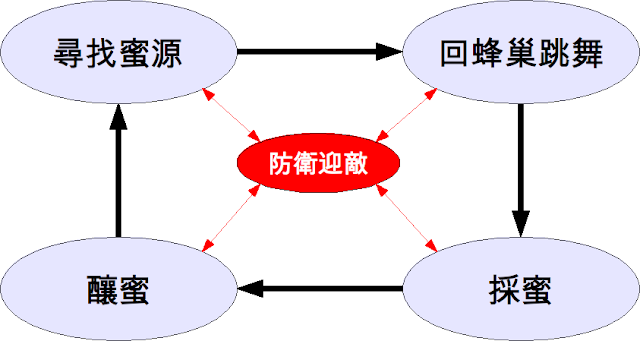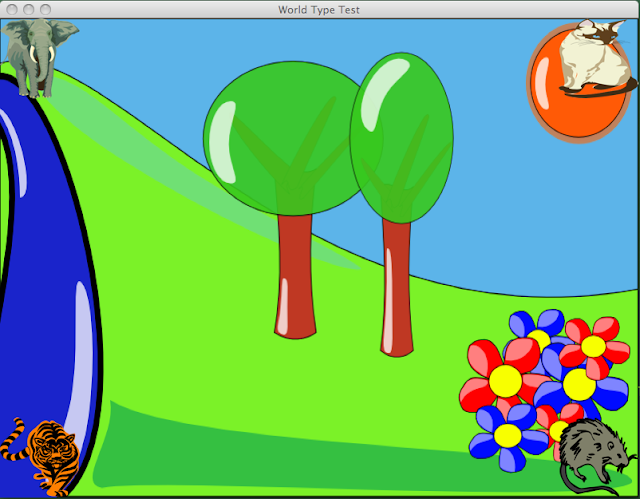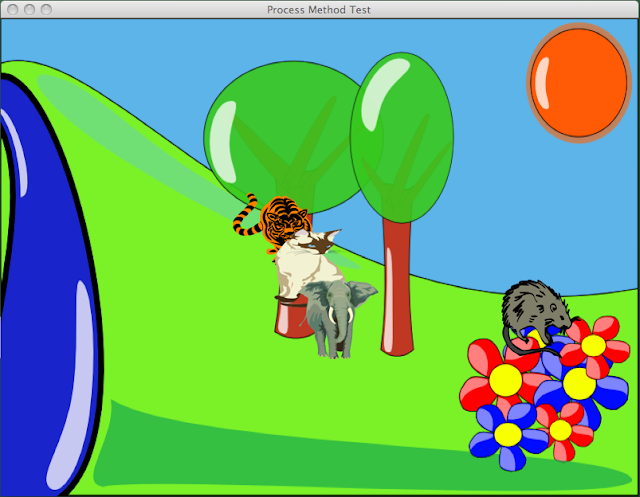角色可以是對手(或敵對),也可以是夥伴,端視遊戲規劃而定。其實,上一章中我們所加入的灰色球拍已經可以算是簡單的人工智慧了。怎麼說呢?player1control()函數中,當球的y座標遞減到400以下的時候,我們設定的灰色球拍便開始隨球的x座標移動,球往左,灰色球拍也往左,同樣的,球向右,灰色球拍也朝右邊移動。
乍看之下灰色球拍彷彿具有一定的智能,可以看得到球的位置,然後隨著球移動的方向嘗試去接球。不論灰色球拍是不是真的很聰明,仍是表現出具有智能的行為,我們若沒有對「智慧」有嚴格的定義與申論,我們說灰色球拍已經具備人工的「智慧」。
程式設計中所謂的人工智慧原文為artificial intelligence,實際的詞意比較接近中文的「人造的智能」,這裡,我們沿用的是常用的「人工智慧」一詞。以日常的用語而言,不論是智慧還是智能,某種程度上來說,好像都是只有我們人類所獨有,正因我們人類有智慧(或智能),利用雙手創造工具,並以工具輔助各種日常事務,從而有人說萬物之靈、統治地球之類讚頌詞語。
但是由觀察其他生物如何去討生活,我們會發現如蜜蜂,工蜂每天在早上離開蜂巢尋找蜜源,找到後便回到蜂巢以跳舞的方式告知其他工蜂蜜源的方向及距離,然後大批工蜂前往採蜜。除了出外採蜜的工蜂,蜂巢內的工蜂也沒閒著,除了照顧女王蜂外,還要餵食幼蟲直到化蛹。若是突然有外來者入侵蜂巢,大批工蜂便會群起攻擊。
我們可以說工蜂每天都處於不同的狀態,譬如出外採蜜的工蜂,尋找蜜源、找到後回蜂巢跳舞,接著出外採蜜分別屬於三種狀態,工蜂的行為往往就是完成一個狀態的工作後,從原先的狀態轉換到另一種狀態。採蜜工作完成後就是釀蜜,這是屬於第四種狀態。我們將這四種狀態的輪替用下圖表示。

偶有突發狀態則是外來者入侵,蜜蜂為了防衛而進行攻擊,所以「防衛迎敵」是個特別的狀態,只要發生就會主動在這四個主要狀態間切換。工蜂每天週而復始的在尋找蜜源、找到蜜源後回蜂巢跳舞、工蜂往蜜源處採蜜、採蜜完成回蜂巢釀蜜,這四個狀態間循環。
許多生物的行為都能以各種狀態分別來解析,因為某些條件的改變,所以從原先的狀態轉換到另一種狀態。我們規劃遊戲角色的時候亦同,除了賦予特定角色專屬的能力與責任,使其依能力盡到他的責任,而且該角色也會在不同狀態間切換。例如即時戰略遊戲中士兵會進行探索,該士兵發現敵人後便進行攻擊,探索、攻擊便分屬兩個不同的狀態。
那如果我們要用程式模擬具有狀態轉換的行為,應該要怎麼設計呢?
回顧鬥獸棋
乒乓球遊戲我們全以函數發展,這是因為我們事前由模擬球的移動,然後一步一步的將遊戲所需的各個元件加入,由於各個元件的需求都很清楚,所以在構築整個遊戲的時候,除了使用Pygame內建的物件以外,大都是以函數來發展。
發展程式的方法哪一種好呢?函數還是自訂新的物件型態?我們建議依需求而定,函數通常單純的做一些事情,物件可以帶有更多的附加屬性,其內定義的方法則提供做事情的能力。新物件可以讓我們跳脫Pygame模組庫的層次,反倒是以遊戲本身的概念進行規劃,從而可以簡化程式的開發過程。
這就跟第四章開始發展的鬥獸棋遊戲一樣,我們自己定義新的型態(新的物件)後,便能將許多資訊封裝、隱藏到型態內,需要用到時再以小數點記號的方式存取或利用。接下來,我們把這個遊戲轉換到Pygame視窗上,同時也讓遊戲多一點趣味。
鬥獸棋的生存遊戲原本在4×4棋盤上,現在我們將四隻動物分別用圖片代替,然後移到800×600的視窗上,並讓每隻動物「探索」整個區域,某隻動物若發現獵物,就會進行「捕捉」。因此,各個角色都會在「探索」與「捕捉」兩種狀態間切換,如下圖。

每一隻動物在遊戲開始的時候都處於「探索」狀態,會依兩種情況而改變狀態,發現獵物後直接轉換為「捕捉」狀態,若是被吃則停止遊戲中的活動,這時圖示可改為灰階,或是不再顯示該圖片,藉以表示該動物已經被吃掉。
「捕捉」狀態下,若是吃到獵物,狀態就會切換回「探索」,每隻動物在遊戲中就會不斷在「探索」與「捕捉」兩種狀態間進行,直到只剩下最後一隻動物為止。
我們會以自訂型態的方式定義狀態,然後以狀態機器處理狀態的改變。當然,每一隻動物都也都屬於各自的型態,但由於基本的性質相同,所以我們會先定義一個Animal型態,囊括所有共通的屬性。
這將會有表示象、虎、貓、鼠四個物件,除此之外,四隻動物所在的世界,也就是包括背景圖的整個區域,我們同樣以定義物件(新的型態)的方式來統籌處理,使各個物件負擔各自的工作,實際Pygame圖形處理的資訊則被隱藏到新物件的定義之中。
建立World
我們定義World型態處理遊戲的世界,先以一個簡單的例子說明整體的運作模式,程式碼如下。
1 2 3 4 5 6 7 8 9 10 11 12 13 14 15 16 17 18 19 20 21 22 23 24 25 26 27 28 29 30 31 32 33 34 35 36 37 38 39 40 41 42 43 44 45 46 47 48 49 50 51 52 53 54 55 56 57 | #《電腦做什麼事》的範例程式碼 http://pydoing.blogspot.com/import pygamefrom pygame.locals import *from sys import exitfrom gameobjects.vector2 import Vector2screen_size = (800, 600)title = "World Type Test"background_image_file = "background.png"elephant_image_file = "ge.png"tiger_image_file = "gt.png"cat_image_file = "gc.png"mouse_image_file = "gm.png"class World(object): def __init__(self): self.background = pygame.image.load(background_image_file).convert() elephant_image = pygame.image.load(elephant_image_file).convert_alpha() tiger_image = pygame.image.load(tiger_image_file).convert_alpha() cat_image = pygame.image.load(cat_image_file).convert_alpha() mouse_image = pygame.image.load(mouse_image_file).convert_alpha() w, h = screen_size elephant_data = [elephant_image, Vector2(0, 0)] tiger_data = [tiger_image, Vector2(0, h-tiger_image.get_height())] cat_data = [cat_image, Vector2(w-cat_image.get_width(), 0)] mouse_data = [mouse_image, Vector2(w-mouse_image.get_width(), h-mouse_image.get_height())] self.species = {"elephant":elephant_data, "tiger":tiger_data, "cat":cat_data, "mouse":mouse_data} def render(self, screen): screen.blit(self.background, (0, 0)) for being in self.species.values(): screen.blit(being[0], being[1])def run(): pygame.init() screen = pygame.display.set_mode(screen_size, 0, 32) pygame.display.set_caption(title) world = World() while True: for event in pygame.event.get(): if event.type == QUIT: exit() world.render(screen) pygame.display.update()if __name__ == "__main__": run() |
World型態裡頭定義了兩個屬性,background就是背景圖的部份,而species用來儲存四隻動物的資料,由於我們要在800×600視窗的四個角落個別放置象、虎、貓、鼠,因此變數elephant_data、tiger_data、cat_data與mouse_data包含圖形轉換後的Surface物件,以及計算個別的座標值。
我們處理座標用了Google Code中gameobjects專案釋出的Vector2型態,這是為了稍後計算座標的兩點距離….等等之用,此專案以New BSD License授權。
另外在World型態中定義了render()方法,用來進行個別圖檔輸出到視窗中的動作。因為這個例子的目的在於把四隻動物放到視窗中,所以,run()函數裡先建立World()型態的變數world,然後主要遊戲迴圈只是簡單的呼叫render()方法,結果如下圖。

第一篇中的鬥獸棋遊戲的主要進行模式寫在handle()函數之中,這裡,我們利用自行定義的World物件來涵蓋處理遊戲世界的一切,因此,render()方法處理Pygame的繪圖工作,我們稍後會另外定義process()方法囊括遊戲的進行模式。
建立Animal
前面的例子說明World物件的用處,接下來我們要替四隻動物規劃共通的特性,也就是定義Animal型態,如下。
1 2 3 4 5 6 7 8 9 10 11 12 13 | #《電腦做什麼事》的範例程式碼 class Animal(object): def __init__(self, name, image, pos): self.alive = True self.name = name self.image = image self.location = pos self.speed = 100. def render(self, screen): screen.blit(self.image, self.location) |
屬性alive表示存活情況,若是被吃掉以後則會轉為False,name為名稱,分別會以象、虎、貓、鼠的英文“elephant”、“tiger”、“cat”、“mouse”表示,image為載入的圖檔,location是圖檔在視窗的位置座標,speed則是圖檔移動的速度,雖然這裡還不會用到,但是我們先做定義。
Animal型態也有render()方法,主要的原因為圖檔及圖檔的位置座標都為其屬性,因而render()方法需要在Animal型態內定義。
我們還需要定義繼承自Animal型態的Elephant、Tiger、Cat、Mouse四種型態,作為表示象、虎、貓、鼠等動物之用。
1 2 3 4 5 6 7 8 9 10 11 12 13 14 15 16 17 18 19 20 21 22 | #《電腦做什麼事》的範例程式碼 class Elephant(Animal): def __init__(self, image, pos): Animal.__init__(self, "elephant", image, pos) self.food = ["tiger", "cat"]class Tiger(Animal): def __init__(self, image, pos): Animal.__init__(self, "tiger", image, pos) self.food = ["cat", "mouse"]class Cat(Animal): def __init__(self, image, pos): Animal.__init__(self, "cat", image, pos) self.food = ["mouse"]class Mouse(Animal): def __init__(self, image, pos): Animal.__init__(self, "mouse", image, pos) self.food = ["elephant"] |
除了名稱作為預設的參數外,另外增加了屬性food,其儲存該隻動物可以吃的其他動物。
我們這裡將四隻動物改由Elephant、Tiger、Cat、Mouse等物件來建立,因此World型態的初始化方法也要有所改變,如下。
1 2 3 4 5 6 7 8 9 10 11 12 13 14 15 | #《電腦做什麼事》的範例程式碼 class World(object): def __init__(self, image): self.background = image self.species = {} def add_being(self, being): self.species[being.name] = being def render(self, screen): screen.blit(self.background, (0, 0)) for being in self.species.values(): being.render(screen) |
屬性background與Animal型態的屬性image相同,直接以轉換完的Surface物件作為參數,species改為空的字典,所以多定義了add_being(),用以增加新的動物,也就是Elephant、Tiger、Cat、Mouse等物件。
新版World型態的render()方法與之前稍有不同,這裡是呼叫species中每個物件,然後執行各自的render()方法。
由於圖檔的Surface物件都被當成參數,所以轉換圖檔的工作要在主要遊戲迴圈開始之前,所有的程式碼如下。
1 2 3 4 5 6 7 8 9 10 11 12 13 14 15 16 17 18 19 20 21 22 23 24 25 26 27 28 29 30 31 32 33 34 35 36 37 38 39 40 41 42 43 44 45 46 47 48 49 50 51 52 53 54 55 56 57 58 59 60 61 62 63 64 65 66 67 68 69 70 71 72 73 74 75 76 77 78 79 80 81 82 83 84 85 86 87 88 89 | #《電腦做什麼事》的範例程式碼 http://pydoing.blogspot.com/import pygamefrom pygame.locals import *from sys import exitfrom gameobjects.vector2 import Vector2screen_size = (800, 600)title = "Aminal Type Test"background_image_file = "background.png"elephant_image_file = "ge.png"tiger_image_file = "gt.png"cat_image_file = "gc.png"mouse_image_file = "gm.png"class World(object): def __init__(self, image): self.background = image self.species = {} def add_being(self, being): self.species[being.name] = being def render(self, screen): screen.blit(self.background, (0, 0)) for being in self.species.values(): being.render(screen)class Animal(object): def __init__(self, name, image, pos): self.alive = True self.name = name self.image = image self.location = pos def render(self, screen): screen.blit(self.image, self.location)class Elephant(Animal): def __init__(self, image, pos): Animal.__init__(self, "elephant", image, pos) self.food = ["tiger", "cat"]class Tiger(Animal): def __init__(self, image, pos): Animal.__init__(self, "tiger", image, pos) self.food = ["cat", "mouse"]class Cat(Animal): def __init__(self, image, pos): Animal.__init__(self, "cat", image, pos) self.food = ["mouse"]class Mouse(Animal): def __init__(self, image, pos): Animal.__init__(self, "mouse", image, pos) self.food = ["elephant"]def run(): pygame.init() screen = pygame.display.set_mode(screen_size, 0, 32) pygame.display.set_caption(title) background_image = pygame.image.load(background_image_file).convert() elephant_image = pygame.image.load(elephant_image_file).convert_alpha() tiger_image = pygame.image.load(tiger_image_file).convert_alpha() cat_image = pygame.image.load(cat_image_file).convert_alpha() mouse_image = pygame.image.load(mouse_image_file).convert_alpha() w, h = screen_size world = World(background_image) world.add_being(Elephant(elephant_image, Vector2(0, 0))) world.add_being(Tiger(tiger_image, Vector2(0, h-tiger_image.get_height()))) world.add_being(Cat(cat_image, Vector2(w-cat_image.get_width(), 0))) world.add_being(Mouse(mouse_image, Vector2(w-mouse_image.get_width(), h-mouse_image.get_height()))) while True: for event in pygame.event.get(): if event.type == QUIT: exit() world.render(screen) pygame.display.update() if __name__ == "__main__": run() |
新程式的執行結果會與稍早相同,接下來,我們開始思考如何讓每隻動物進行探索。
探索:隨機的在視窗中移動
我們的每隻動物在Pygame視窗中分別都是一張圖檔,若是要讓每隻動物進行探索的工作,實際上也就是讓該張代表動物的圖檔隨機的在視窗中移動。這該怎麼寫出程式呢?我們設想在Animal型態中增加一個behave()方法,用來表現出該隻動物的行為。
因為探索的行為具有隨機性,我們先寫一個在Animal型態中決定隨機移動方向的方法。
1 2 3 4 5 6 7 | #《電腦做什麼事》的範例程式碼 def random_destination(self): w, h = screen_size if randint(1, 20) == 1: self.destination = Vector2(randint(1, w-1), randint(1, h-1)) |
我們增加了一個destination屬性,其作為目的地的位置座標,所以random_destination()方法有二十分之一的機率,可以隨機的指派視窗中的座標值給屬性destination,也就是x座標介於1到799,y座標介於1到599之間的位置。
因為用了randint()函數,所以在前面引入模組的地方要加上
1 2 3 4 |
behave()方法的定義中要先呼叫random_destination()方法。
1 2 3 4 5 6 7 8 9 10 11 12 | #《電腦做什麼事》的範例程式碼 def behave(self, time): self.random_destination() if self.speed > 0.0 and self.location != self.destination: destination_vector = self.destination - self.location destination_distance = destination_vector.get_length() heading = destination_vector.get_normalized() travel_distance = min(destination_distance, time * self.speed) self.location += travel_distance * heading |
behave()方法需要一個time參數,這是用為控制每一次視窗的重新繪圖所經過的時間。呼叫random_destination()方法後,接著做一個條件判斷,假設速度大於0,並且必須是目的座標與所在的位置座標不相等,然後做一些數學計算,將動物圖檔移動的距離算出來,儲存到變數travel_distance之中,再將這個距離與location屬性相加。
那我們要在哪裡呼叫behave()方法呢?雖然可以直接寫在World型態的render()方法之內,但是這樣有點不完全符合render()方法的用途,所以我們要在World型態中另外定義process()方法,其內呼叫Animal物件的behave()方法,如下。
1 2 3 4 5 6 | #《電腦做什麼事》的範例程式碼 def process(self, time): for being in self.species.values(): being.behave(time) |
別忘了進入主要遊戲迴圈之前要先建立控制時間的clock變數,我們將到目前為止的程式碼摘錄如下。
1 2 3 4 5 6 7 8 9 10 11 12 13 14 15 16 17 18 19 20 21 22 23 24 25 26 27 28 29 30 31 32 33 34 35 36 37 38 39 40 41 42 43 44 45 46 47 48 49 50 51 52 53 54 55 56 57 58 59 60 61 62 63 64 65 66 67 68 69 70 71 72 73 74 75 76 77 78 79 80 81 82 83 84 85 86 87 88 89 90 91 92 93 94 95 96 97 98 99 100 101 102 103 104 105 106 107 108 109 110 111 112 113 114 115 116 117 118 119 120 | #《電腦做什麼事》的範例程式碼 import pygamefrom pygame.locals import *from sys import exitfrom random import randintfrom gameobjects.vector2 import Vector2screen_size = (800, 600)title = "Process Method Test"background_image_file = "background.png"elephant_image_file = "ge.png"tiger_image_file = "gt.png"cat_image_file = "gc.png"mouse_image_file = "gm.png"class World(object): def __init__(self, image): self.background = image self.species = {} def add_being(self, being): self.species[being.name] = being def render(self, screen): screen.blit(self.background, (0, 0)) for being in self.species.values(): being.render(screen) def process(self, time): for being in self.species.values(): being.behave(time)class Animal(object): def __init__(self, name, image, pos): self.alive = True self.name = name self.image = image self.location = pos w, h = screen_size self.destination = Vector2(randint(1, w), randint(1, h)) self.speed = 100.0 def render(self, screen): screen.blit(self.image, self.location) def random_destination(self): w, h = screen_size if randint(1, 20) == 1: self.destination = Vector2(randint(1, w), randint(1, h)) def behave(self, time): self.random_destination() if self.speed > 0.0 and self.location != self.destination: destination_vector = self.destination - self.location destination_distance = destination_vector.get_length() heading = destination_vector.get_normalized() travel_distance = min(destination_distance, time * self.speed) self.location += travel_distance * headingclass Elephant(Animal): def __init__(self, image, pos): Animal.__init__(self, "elephant", image, pos) self.food = ["tiger", "cat"]class Tiger(Animal): def __init__(self, image, pos): Animal.__init__(self, "tiger", image, pos) self.food = ["cat", "mouse"]class Cat(Animal): def __init__(self, image, pos): Animal.__init__(self, "cat", image, pos) self.food = ["mouse"]class Mouse(Animal): def __init__(self, image, pos): Animal.__init__(self, "mouse", image, pos) self.food = ["elephant"]def run(): pygame.init() screen = pygame.display.set_mode(screen_size, 0, 32) pygame.display.set_caption(title) background_image = pygame.image.load(background_image_file).convert() elephant_image = pygame.image.load(elephant_image_file).convert_alpha() tiger_image = pygame.image.load(tiger_image_file).convert_alpha() cat_image = pygame.image.load(cat_image_file).convert_alpha() mouse_image = pygame.image.load(mouse_image_file).convert_alpha() w, h = screen_size world = World(background_image) world.add_being(Elephant(elephant_image, Vector2(0, 0))) world.add_being(Tiger(tiger_image, Vector2(0, h-tiger_image.get_height()))) world.add_being(Cat(cat_image, Vector2(w-cat_image.get_width(), 0))) world.add_being(Mouse(mouse_image, Vector2(w-mouse_image.get_width(), h-mouse_image.get_height()))) clock = pygame.time.Clock() while True: for event in pygame.event.get(): if event.type == QUIT: exit() seconds = clock.tick(30) / 1000.0 world.process(seconds) world.render(screen) pygame.display.update() if __name__ == "__main__": run() |
執行結果如下圖。

建立Exploring
上一節中,我們將動物的行為(隨機的在視窗中移動)寫在Animal型態的behave()方法裡,這一節我們將之改以狀態及狀態機器的設計方式。
首先,我們以State型態,將各種狀態共通的方法、屬性先行定義。
1 2 3 4 5 6 7 8 9 | #《電腦做什麼事》的範例程式碼 class State(object): def __init__(self, name): self.name = name def do_actions(self): pass |
屬性name為狀態的名稱,方法do_actions()則在此狀態下的行為,底下的pass陳述表示在這裡不做任何事情,我們寫出來的意義是說明State及繼承自State的型態會有方法do_actions(),至於實際do_actions()的內容,稍後定義繼承State的新型態再做定義。
接下來我們定義作為探索的Exploring型態。
1 2 3 4 5 6 7 8 9 10 11 12 13 14 15 16 17 18 19 20 21 22 | #《電腦做什麼事》的範例程式碼 class Exploring(State): def __init__(self, being): State.__init__(self, "exploring") self.being = being def random_destination(self): w, h = screen_size if randint(1, 20) == 1: self.being.destination = Vector2(randint(1, w-1), randint(1, h-1)) def do_actions(self, time): self.random_destination() if self.being.speed > 0.0 and self.being.location != self.being.destination: destination_vector = self.being.destination - self.being.location destination_distance = destination_vector.get_length() heading = destination_vector.get_normalized() travel_distance = min(destination_distance, time * self.being.speed) self.being.location += travel_distance * heading |
繼承自State型態,同時需要多一個參數,這個參數為動物的物件型態。為什麼要有一個動物的物件型態做參數呢?這是因為我們要將之前定義在Animal型態中的random_destination()及behave()方法移過來,後者的內容放到do_actions()方法之內,由於座標是屬於動物的物件屬性,所以在Exploring型態需要用動物的物件型態做參數。
於是原本behave()方法中的speed、location等屬性,到了do_actions()方法中都要改為being.speed、being.location等,這使Elephant、Tiger、Cat、Mouse等物件中的座標屬性值跟著程式進行而改變。
另外,我們需要一個狀態機器來管理所有的狀態,這需要定義的是StateMachine型態。
1 2 3 4 5 6 7 8 9 10 11 12 13 14 15 16 17 18 19 | #《電腦做什麼事》的範例程式碼 class StateMachine(object): def __init__(self): self.states = {} self.active_state = None def add_state(self, state): self.states[state.name]= state def think(self, time): if self.active_state is None: return self.active_state.do_actions(time) def set_state(self, new_state_name): self.active_state = self.states[new_state_name] |
所有的狀態用屬性states來儲存,而目前的狀態則是以active_state來表示,add_state()方法替狀態機器(StateMachine型態)加入新的狀態,set_state()方法則設定目前的狀態,think()方法使物件判斷該做什麼事情,包括程式進行時控制狀態的改變,由於目前只有一種狀態,所以think()就只有簡單的呼叫do_actions()方法。
我們還要替原先的Animal型態增加一個屬性brain。
1 2 3 4 |
然後其內原先behave()方法則改為呼叫think()方法。
1 2 3 4 5 |
如此我們有了一個狀態,讓動物隨機的探索視窗區域,同時可以繼續延伸讓狀態改變,從而讓動物表現不同的行為,到目前為所有的程式如下。
1 2 3 4 5 6 7 8 9 10 11 12 13 14 15 16 17 18 19 20 21 22 23 24 25 26 27 28 29 30 31 32 33 34 35 36 37 38 39 40 41 42 43 44 45 46 47 48 49 50 51 52 53 54 55 56 57 58 59 60 61 62 63 64 65 66 67 68 69 70 71 72 73 74 75 76 77 78 79 80 81 82 83 84 85 86 87 88 89 90 91 92 93 94 95 96 97 98 99 100 101 102 103 104 105 106 107 108 109 110 111 112 113 114 115 116 117 118 119 120 121 122 123 124 125 126 127 128 129 130 131 132 133 134 135 136 137 138 139 140 141 142 143 144 145 146 147 148 149 150 151 152 153 154 155 156 157 158 159 160 161 162 163 164 165 166 167 168 169 170 171 172 173 174 | #《電腦做什麼事》的範例程式碼 http://pydoing.blogspot.com/import pygamefrom pygame.locals import *from sys import exitfrom random import randintfrom gameobjects.vector2 import Vector2screen_size = (800, 600)title = "State Type Test"background_image_file = "background.png"elephant_image_file = "ge.png"tiger_image_file = "gt.png"cat_image_file = "gc.png"mouse_image_file = "gm.png"class State(object): def __init__(self, name): self.name = name def do_actions(self): passclass Exploring(State): def __init__(self, being): State.__init__(self, "exploring") self.being = being def random_destination(self): w, h = screen_size if randint(1, 20) == 1: self.being.destination = Vector2(randint(1, w-1), randint(1, h-1)) def do_actions(self, time): self.random_destination() if self.being.speed > 0.0 and self.being.location !=self.being.destination: destination_vector = self.being.destination - self.being.location destination_distance = destination_vector.get_length() heading = destination_vector.get_normalized() travel_distance = min(destination_distance, time * self.being.speed) self.being.location += travel_distance * heading class StateMachine(object): def __init__(self): self.states = {} self.active_state = None def add_state(self, state): self.states[state.name]= state def think(self, time): if self.active_state is None: return self.active_state.do_actions(time) def set_state(self, new_state_name): self.active_state = self.states[new_state_name]class World(object): def __init__(self, image): self.background = image self.species = {} def add_being(self, being): self.species[being.name] = being def render(self, screen): screen.blit(self.background, (0, 0)) for being in self.species.values(): being.render(screen) def process(self, time): for being in self.species.values(): being.behave(time)class Animal(object): def __init__(self, name, image, pos): self.alive = True self.name = name self.image = image self.location = pos w, h = screen_size self.destination = Vector2(randint(1, w), randint(1, h)) self.speed = 100.0 self.brain = StateMachine() def render(self, screen): screen.blit(self.image, self.location) def behave(self, time): self.brain.think(time)class Elephant(Animal): def __init__(self, image, pos): Animal.__init__(self, "elephant", image, pos) self.food = ["tiger", "cat"] self.brain.add_state(Exploring(self))class Tiger(Animal): def __init__(self, image, pos): Animal.__init__(self, "tiger", image, pos) self.food = ["cat", "mouse"] self.brain.add_state(Exploring(self))class Cat(Animal): def __init__(self, image, pos): Animal.__init__(self, "cat", image, pos) self.food = ["mouse"] self.brain.add_state(Exploring(self))class Mouse(Animal): def __init__(self, image, pos): Animal.__init__(self, "mouse", image, pos) self.food = ["elephant"] self.brain.add_state(Exploring(self))def run(): pygame.init() screen = pygame.display.set_mode(screen_size, 0, 32) pygame.display.set_caption(title) background_image = pygame.image.load(background_image_file).convert() elephant_image = pygame.image.load(elephant_image_file).convert_alpha() tiger_image = pygame.image.load(tiger_image_file).convert_alpha() cat_image = pygame.image.load(cat_image_file).convert_alpha() mouse_image = pygame.image.load(mouse_image_file).convert_alpha() world = World(background_image) w, h = screen_size elephant = Elephant(elephant_image, Vector2(0, 0)) elephant.brain.set_state("exploring") world.add_being(elephant) tiger = Tiger(tiger_image, Vector2(0, h-tiger_image.get_height())) tiger.brain.set_state("exploring") world.add_being(tiger) cat = Cat(cat_image, Vector2(w-cat_image.get_width(), 0)) cat.brain.set_state("exploring") world.add_being(cat) mouse = Mouse(mouse_image, Vector2(w-mouse_image.get_width(), h-mouse_image.get_height())) mouse.brain.set_state("exploring") world.add_being(mouse) clock = pygame.time.Clock() while True: for event in pygame.event.get(): if event.type == QUIT: exit() seconds = clock.tick(30) / 1000.0 world.process(seconds) world.render(screen) pygame.display.update() if __name__ == "__main__": run() |
結果會與上一節相同。
重提State
我們若是繼續發展,State型態也需要適當的擴充,如下。
1 2 3 4 5 6 7 8 9 10 11 12 13 14 15 16 17 18 | #《電腦做什麼事》的範例程式碼 class State(object): def __init__(self, name): self.name = name def entry_actions(self): pass def do_actions(self): pass def exit_actions(self): pass def check_conditions(self): pass |
進入某一狀態就呼叫entry_actions()方法,離開狀態呼叫exit_actions()方法,在該狀態裡面則是執行do_actions()方法,另外利用check_conditions()方法進行狀態的改變的檢查。
所以StateMachine型態的think()方法要更改如下。
1 2 3 4 5 6 7 8 9 10 11 12 | #《電腦做什麼事》的範例程式碼 def think(self, time): if self.active_state is None: return self.active_state.do_actions() new_state_name = self.active_state.check_conditions() if new_state_name is not None: self.set_state(new_state_name) |
主要是增加了狀態的條件檢查,也就是呼叫check_conditions()方法,若是條件符合另一種狀態時,譬如「貓」走近到「虎」的附近,我們使「虎」感知到「貓」的靠近,於是「虎」的狀態由「探索」轉變為「捕捉」,「貓」的所在座標就變成「虎」的目的座標,形成「捕捉」的行為。
這時候set_state()方法也要稍微修改。
1 2 3 4 5 6 7 8 9 | #《電腦做什麼事》的範例程式碼 def set_state(self, new_state_name): if self.active_state is not None: self.active_state.exit_actions() self.active_state = self.states[new_state_name] self.active_state.entry_actions() |
狀態改變前先呼叫exit_actions()方法,如「虎」大叫一聲,然後設定成新的捕捉狀態,接著呼叫entry_actions()方法,這時如「虎」加快速度,往「貓」跑去的動作就是呼叫捕捉狀態的do_actions()方法。
我們遊戲的人工智慧大致發展到這裡,同時也說明了以物件為主的程式發展。
下一步
Pygame模組庫除了圖形顯示外,還有許多其他的功能,如Mixer可以載入與處理音效,Joystick可以設定遊戲控制桿等……,我們的介紹以程式設計的概念與發展為主軸,因此還有許多Pygame精彩的地方只好略去不提了。
若是對Pygame想要深入研究,官網上的Tutorials頁提供了其他的教材,另外官網所建議的Beginning Game Development with Python and Pygame: From Novice to Professional也是一本絕佳的參考書籍。
下一章,我們開始介紹另一個圖形介面的模組庫 --- wxPython,來看看如何利用Python發展應用程式介面。